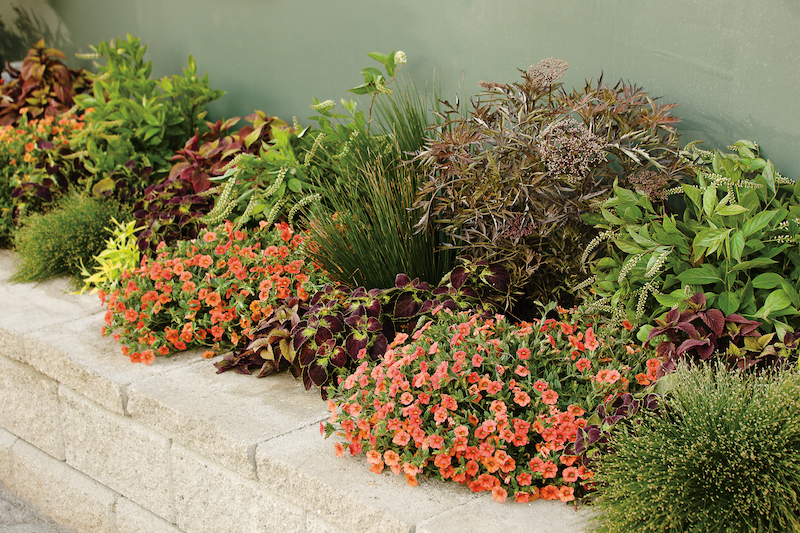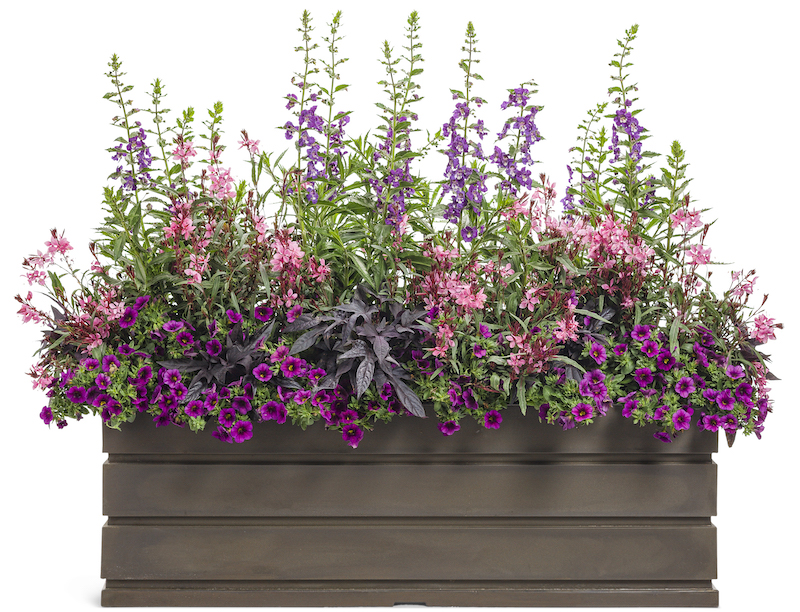Calibrachoa is a tender perennial often grown as an annual. This plant adds a punch of color throughout the summer growing season, demanding little maintenance to keep it looking fresh and tidy. Used mainly in containers or hanging baskets, Calibrachoa can also be planted in a garden bed as a companion to smaller shrubs and perennials and is perfect for a temporary ground cover to fill in empty spots.
The range of bright multicolored flowers is versatile to contrast or complement just about any flower color. Although this trailing annual may look delicate and fussy, it is just as tough as any perennial or hardy annual when given the right growing conditions. The number one issue to watch with Calibrachoa is overwatering in containers or planting in soil that does not drain well. Root rot diseases can overtake this plant quickly, resulting in certain death.

Shrubs To Plant With Calibrachoa
Smaller-sized shrubs will work best with Calibrachoa. Sweetspire shrubs and deeply colored Elderberry have interesting foliage and long-lasting flowers in the summer. Calibrachoa makes a great ground cover for these shrubs as it is not an aggressive grower or have a deep root system that would compete for moisture. The hot, vibrant colors of Calibrachoa look great next to the deep burgundy Elderberry foliage, giving any garden a tropical feeling. The Sweetspires’ long flower spikes are a great contrast to the compact and mounding shape of Million Bells.
Perennials To Plant With Calibrachoa
Calibrachoa is brilliant planted as an understory plant with taller growing perennials. Any perennial that prefers well-draining soil and full sun will be successful. Shorter ornamental grasses and Salvias provide contrasting foliage and color and grow readily next to Calibrachoa. The graceful shape and fine texture of most ornamental grasses provide a season-long backdrop for the rounded shapes of calibrachoa foliage and flowers. Salvias can be used as a vertical accent when planted with Calibrachoa and have a longer bloom time than other perennials, deserving a placement in any garden.
Annuals To Plant With Calibrachoa
Tender perennials grown as annuals or true annual plants make the best companions for Calibrachoa. The shallow root systems and similar requirements for full sun and well-drained soil make Nemesia, Celosia, Bacopa, sweet potato vine, snapdragons, and Coleus natural partners to consider. Using annual plants in the garden lets you change up color combinations or placement ideas with relatively little investment, unlike perennial plants.
Annuals can be added throughout the summer to fill in gaps where earlier blooming bulbs or perennials have finished. Calibrachoa will make tidy mounds of bright color to replace earlier blooming bleeding heart, columbine, or daffodils. Adding a slow-release fertilizer to the soil when planting annuals reduces the need for supplemental fertilizing later in the season. As the plants are watered, the fertilizer breaks down in the soil, providing all the nutrients the roots need. Look for a formulation that has an NPK ratio of 1-3-2 to specifically support heavy, long-lasting blooming.

Photo by K M, unmodified, Flickr, copyright CC BY 2.0
Best Companion Plants For Calibrachoa in Containers
Containers filled with flowering annuals are often the highlight of summer deck and patio decorating. While a container filled with annuals is easy to plant and keeps growing well into the fall, adding a few strategic perennials is a game changer. Perennials grown year-round in a planter rarely need extra care over the winter and give the gardener a more permanent element to begin the next season's container design.
Think about planting coral bells, smaller ornamental grasses, or coneflowers as the base element, while filling in the pot with one or two colors of Calibrachoa, and the container is finished. After 2-3 years, perennials that begin to outgrow a container can be divided or relocated to a preferred location in the garden. Hanging baskets overflowing with both Petunias and Calibrachoa are a classic combination that blooms nonstop and can be placed in either full sun or part shade.

Plants Not To Grow With Calibrachoa
Calibrachoa is susceptible to both root rot diseases and sap-sucking pests such as aphids. To minimize the risk, only grow Calibrachoa in locations that have excellent drainage and at least 6 hours of full sun exposure. Growing Calibrachoa in full shade with plants such as ferns, Hellebores, or Hostas will result in slow growth and reduced flowering. Any growth that does happen will be leggy and weak, making the plant more susceptible to a pathogen or pest attack.
Plants that thrive in boggy conditions where the soil stays wet at all times are also not good companions for Calibrachoa. Water rushes, Cattails, or Papyrus Reeds require more moisture than Calibrachoa can tolerate. Overwatering or soggy soil will quickly result in root rot for this annual plant.
Best Plants To Grow With Calibrachoa
Choose plants that thrive in full to part sun and well-draining soil of moderate fertility for the most successful combinations. Foliage texture and flower color should also be considered depending on if you want a vibrant, eclectic mix or a more subdued, monochromatic palette. Some of the best companions include elderberry, salvia, petunias, sweet potato vine, snapdragons, and coleus, which all provide interesting foliage texture or bright color.
 |
Author Robbin Small - Published 8-28-2023 |




